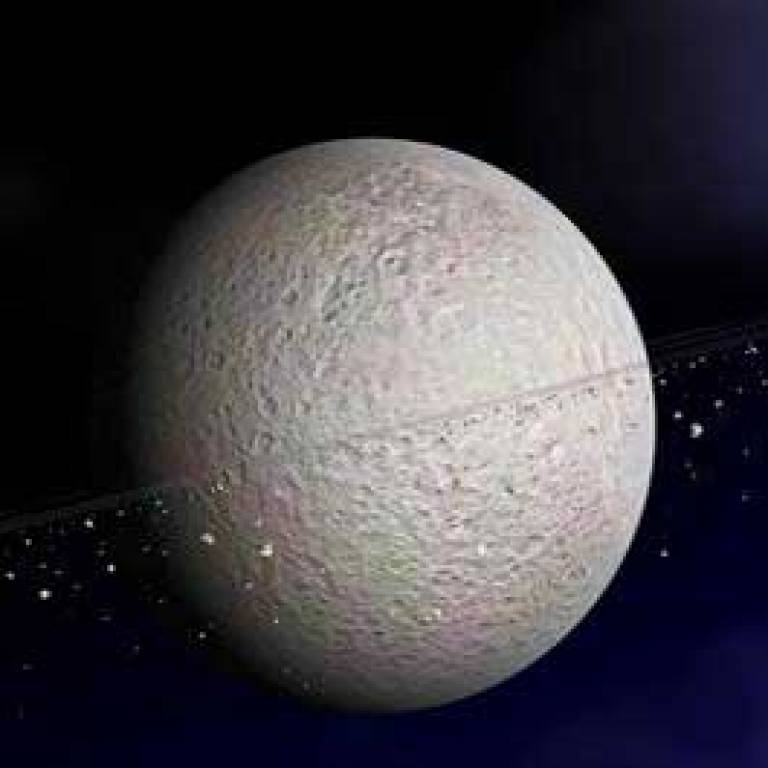Saturn's moon Rhea may have rings, too
17 March 2008
Links:
 ucl.ac.uk/mssl/" target="_self">UCL MSSL
ucl.ac.uk/mssl/" target="_self">UCL MSSL
UCL scientists are part of a team using NASA's Cassini spacecraft, which is currently orbiting Saturn, that have found evidence of material orbiting Rhea, Saturn's second largest moon. This finding is the first time rings may have been found around a moon. Their results are reported in the journal 'Science'.
A broad debris disk and at least one ring appear to have been detected by a suite of six instruments specifically designed to study the atmospheres and particles around Saturn and its moons.
Lead author and Cassini scientist Dr Geraint Jones (UCL Mullard Space Science Laboratory) said: "Until now, only planets were known to have rings, but now Rhea seems to have some family ties."
Rhea is roughly 1,500 km in diameter. The apparent debris disk measures several thousand kilometres from end to end. The particles that make up the disk and any embedded rings probably range from the size of small pebbles to boulders. An additional dust cloud may extend up to 5,900 km from the moon's centre, almost eight times the radius of Rhea.
Since the discovery, Cassini scientists have carried out numerical simulations to determine if Rhea can maintain rings. The models show that Rhea's gravity field, in combination with an apparent 'sweet-spot' orbit around Saturn, could allow rings to remain in place for a very long time.
Launched in 1997, the US/ European mission includes a four-year (2004-2008) detailed exploration of the Saturnian system. The magnetosphere of Saturn is the most complex in the solar system and includes several unique features - large quantities of dust, particularly in the ring plane, icy satellites and Saturn's largest moon, Titan, with its appreciable atmosphere. Cassini carries an electron spectrometer instrument, designed and built at the UCL MSSL, which is also lead co-investigator on the project.
The revelation was a result of a Cassini close flyby of Rhea in November 2005, when six instruments on board Cassini observed the environment round the moon. Three of the instruments sampled the dust directly. The existence of some debris was expected because a rain of dust constantly hits Saturn's moons, including Rhea, knocking particles into space around them. Other instruments' observations showed how the moon was interacting with Saturn's magnetosphere, and ruled out the possibility of an appreciable atmosphere.
Evidence for an additional debris disk came from a gradual drop on either side of Rhea in the number of electrons detected by two of Cassini's instruments; material near Rhea appeared to be shielding Cassini from the usual rain of electrons. Cassini's Magnetospheric Imaging Instrument also detected sharp, brief drops in electrons on both sides of the moon, suggesting the presence of rings within the disk of debris. The rings of Uranus were found in a similar fashion, by NASA's Kuiper Airborne Observatory in 1977, when light from a star blinked on and off as it passed behind Uranus' rings.
"Seeing almost the same signatures on either side of Rhea was the clincher," added Dr Jones. "After ruling out many other possibilities, we said these are most likely rings. No one was expecting rings around a moon."
One possible explanation for these rings is that they are remnants from an asteroid or comet collision in Rhea's distant past. Such a collision may have pitched large quantities of gas and solid particles around Rhea. Once the gas dissipated, all that remained were the ring particles. Other moons of Saturn, like Mimas, for example, show evidence of a catastrophic collision that almost tore the moon apart.
"The sensitivity of the particles and fields instruments on Cassini, together with in-situ dust measurements, have been used here to discover something special. Signs of rings around a moon are truly exciting findings which are a new part of the evolving jigsaw of solar system dynamics" said Professor Andrew Coates (UCL MSSL), co-author and Cassini scientist on the Cassini Plasma Spectrometer.
To find out more, use the links at the top of this article
Image: Artist's Impression of Rhea (Credit: NASA)
 Close
Close

